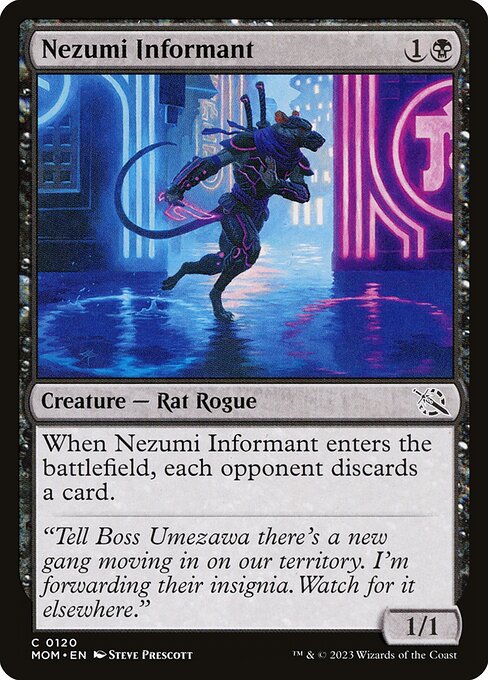
Image courtesy of Scryfall.com
Kamigawa Lore in Focus: Nezumi Informant
In the dim corridors where shadows gossip as loudly as swords clang, a small, watchful eye keeps track of every whispered plot: the Nezumi Informant. This common menace—a two-mana Black creature, a Rat Rogue with a 1/1 frame—serves as a window into the Kamigawa-inspired underworld that threads through March of the Machine. Its quiet menace isn’t flashy, but it hums with the flavor of a world where informants move through alleyways like whispers on lacquered wood. 🧙♂️💎
Flavor text anchors the card to a Kamigawan vibe: “Tell Boss Umezawa there’s a new gang moving in on our territory. I’m forwarding their insignia. Watch for it elsewhere.” That line isn’t just flavor—it’s a bridge between eras and planes. Umezawa is a name steeped in Kamigawa lore, a reminder that old power structures persist even as clockwork and cataclysms reshape the multiverse. The Nezumi Informant embodies the scrappy, street-level cunning that thrives in the shadows of grand conflicts—precisely the flavor you feel when you glimpse a few black cloaks slipping through a neon-lit cityscape. 🔎⚔️
From a lore perspective, the card crystallizes the tension between Old Kamigawa's underworld and the machine-haunted present. The Nezumi, a rat-centric clan in Kamigawa’s ecosystem, evolves into a master of information here: an ETB trigger that makes each opponent discard a card. It’s a compact, thematic reminder that knowledge is power—and sometimes power wears a fur coat and a hood. The flavor and mechanics dovetail nicely with the broader MOM narrative, where volatile alliances and sudden betrayals color every encounter. 🎲
Design, Mechanics, and the Tempo of a Turn
Mechanically, Nezumi Informant is straightforward but potent: a 2-cost Black creature that enters and forces a discard from every opponent. That ETB impact scales with the number of rivals and the state of the battlefield, often putting pressure on slower decks that rely on card advantage to stabilize. Its 1/1 body is intentionally modest, but its presence can cascade into a tempo swing—especially if you’re packing additional discard or reanimation synergies to fuel longer games. The card’s rarity—common in the MOM set—signals a deliberate design choice: this is a nimble early-game disruptive piece, not a bomb, but a reliable engine for grindy boards and control shells. 💎
As a black creature, it fits neatly into archetypes that value disruption over brute force. If you’re drafting or playing Modern- or Legacy-style suites, its ETB discard can pressure opposing acceleration, forcing a misstep or two as you pin back opponents who want to hold their hand close to the chest. And because the effect hits all opponents, it shines in multiplayer formats where the social contract of “everyone discards” can swing alliances and create surprising comebacks. It’s a small card with a big voice—perfect for late-night epic skirmishes with friends who insist on coffee-fueled, mind-bending strategy sessions. 🧙♂️🔥
Lore, Artwork, and Collector’s Insight
The artwork by Steve Prescott carries a noir flavor that complements Kamigawa’s mythic-punk sensibilities. The character design and environment suggest a quiet, always-listening presence—someone who knows more than they reveal and uses that knowledge to their advantage. Collectors alike appreciate the MOM printing for its foils and nonfoils, as well as the card’s accessibility in multiple formats (paper, Arena, MTG Online). Its EDH/Commander plays are often grounded in the disruption of opponents’ hands, while the flavor invites players to imagine the back alleys where information is the true currency. 🎨🔪
The Nezumi Informant’s blend of flavor and function also offers a neat umbrella for storytelling outside the game. In Kamigawa-inspired narratives, informants and conspirators chew through factions, passing messages like smoke signals across bamboo corridors. This card captures that vibe in a two-mana package, inviting players to weave lore into their daily games—one discard at a time. ⚔️🧭
Strategic Spotlight: Building Around a Tiny Trojan Horse
If you’re looking to weave Nezumi Informant into a deck, consider pairing it with discard-focused spells or creatures that reward opponents for discarding. Cards that benefit from opponents discarding or discarding on your terms—fetching engines, reanimation lines, or graveyard-shift tools—can turn theInformant from a simple punt into a recurring source of pressure. It’s also a nice anchor in archetypes that lean into tempo and attrition, where each opponent’s card loss compounds as the game unfolds. And since it’s from MOM, it sits among a broader set of innovative, mechanically diverse cards that push players to rethink typical color roles. 🧙♂️🎲
In practical terms, the Informant’s best moments often occur early, when you can leverage the discard impact to derail an opponent’s tempo while you assemble your own game plan. It’s not a slam-dunk answer to every problem, but its efficiency—two mana for a global hand disruption—offers genuine value in a crowded format that loves efficient threats. If you’re brewing a casual deck or testing a new pirate–assassin–saboteur shell, Nezumi Informant can be a satisfying piece to slot in, bouncing around the table with a sly grin and a ready-to-flip coin. 🧙♂️💥
For readers who enjoy cross-pollinating magic with other spheres of interest, this card sits at an enjoyable crossroads. It speaks to the enduring appeal of Kamigawa’s lore—where clans, families, and informants shape the fate of kingdoms—and it also nods to the modern, machine-saturated storytelling of MOM. The result is a card that’s both flavorful and functional, a tiny spy that reminds us how even the smallest figure can tilt a game or a story with a single, sharp disclosure. 🔎💎
Foot-shaped Ergonomic Memory Foam Wrist Rest Mouse Pad